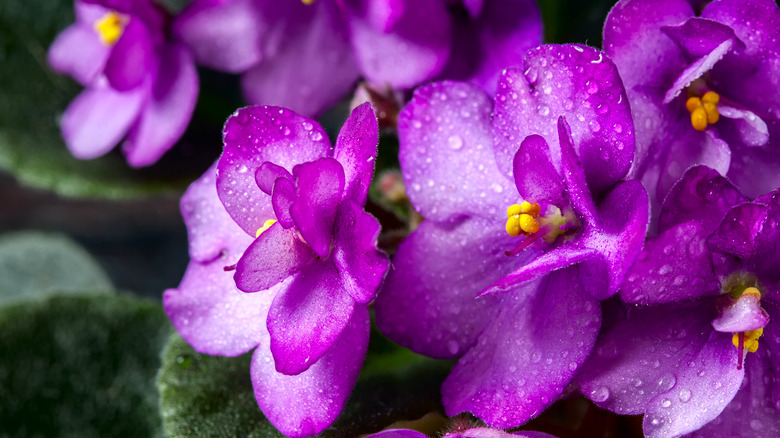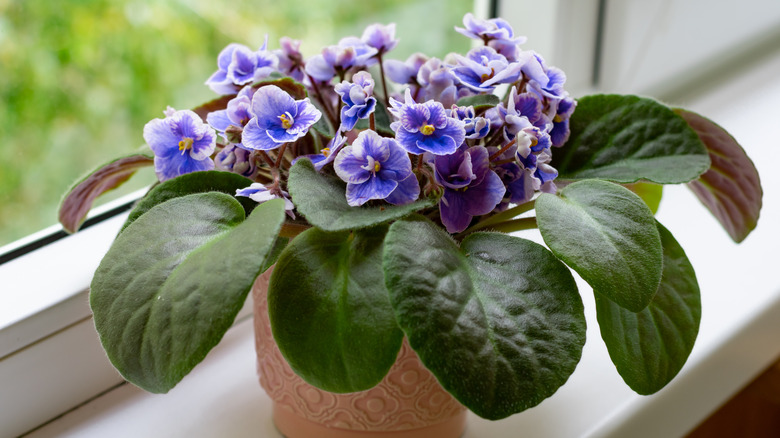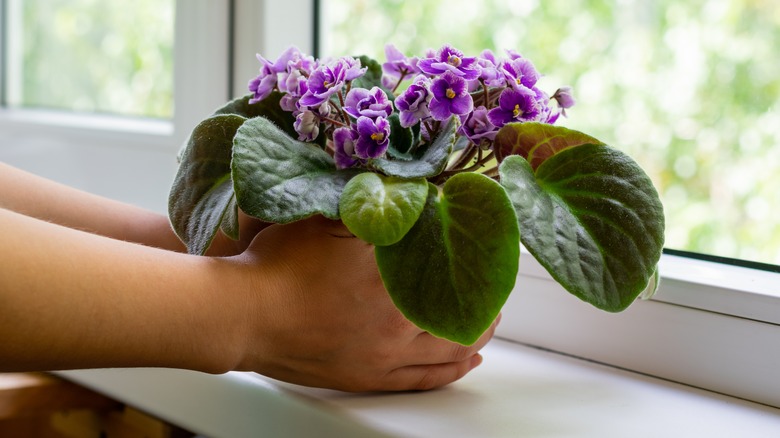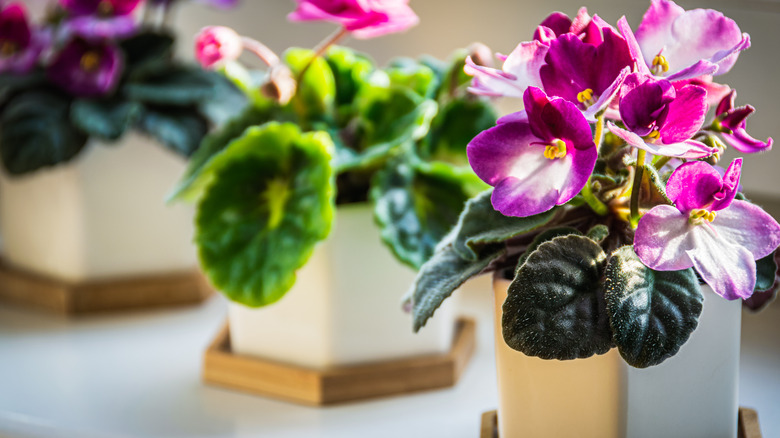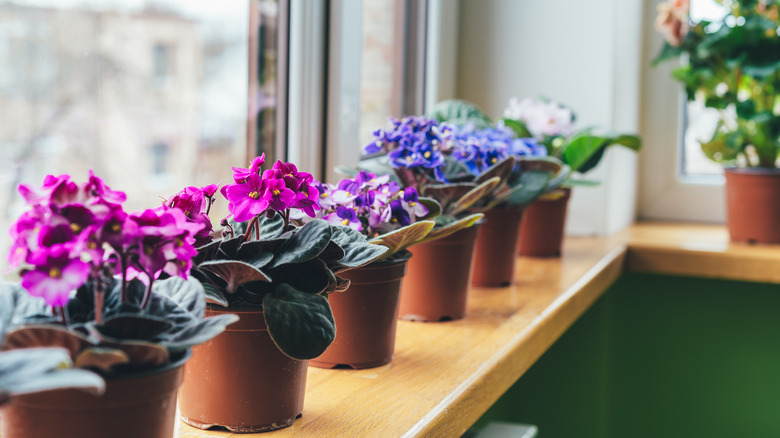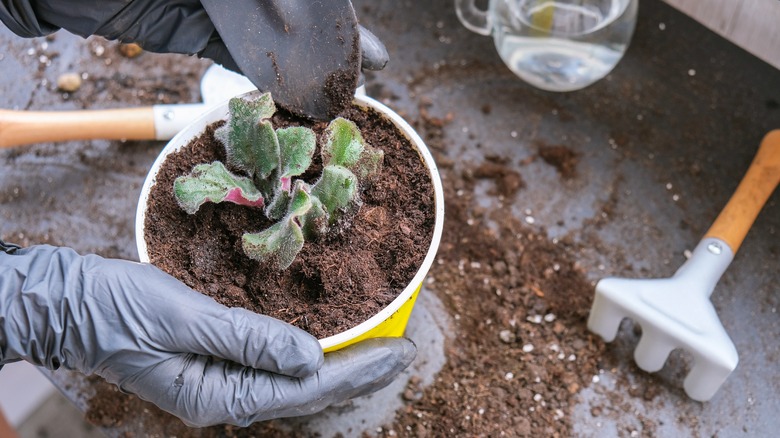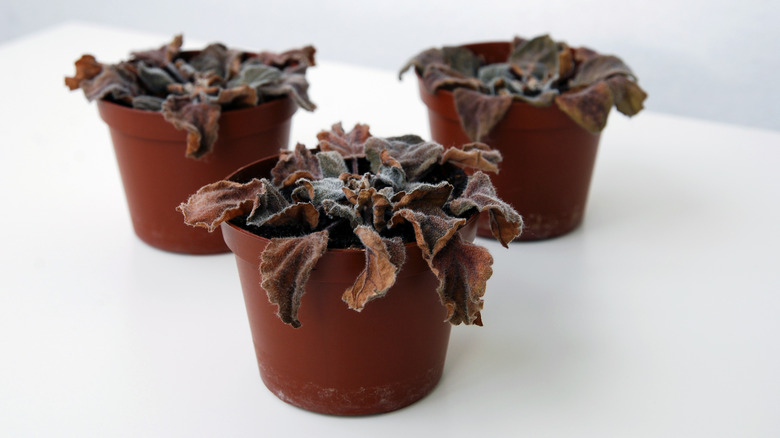How To Successfully Grow African Violets
The African violet, sometimes referred to by its scientific name Saintpaulia, is typically found in its characteristic bright-purple hue. However, certain varieties also feature red, white, pink, and blue petals. According to the African Violet Research Center, this gorgeous compact flower is not a part of the violet family. In fact, its name refers solely to the violet color of its petals. Even if its name is a bit misleading, you will still benefit from the year-round blooms that this plant produces, in addition to its long lifespan of up to 50 years.
You'll be happy to learn that the African violet grows easily indoors and is mainly kept as a houseplant. Growing African violets outdoors should only be attempted if you live in a tropical climate. However, this is not recommended anywhere in the United States. They aren't large plants, growing between 1/2 foot and 3/4 of a foot in both height and width, as per the Missouri Botanical Garden. The blooms grow in a cluster in the middle of the plant while evergreen oblong leaves covered in small hairs branch out around the flowers. It's an easy houseplant to grow and maintain, making it the perfect addition to your household collection of foliage. The following guide will teach you all you need to know about growing and caring for African violets.
How to grow African violets
African violets are among the most popular houseplants due to their hardiness and ability to grow year-round, making them widely available in gardening shops. Once you've purchased an African violet plant, rest assured that the process of propagating it yourself is hassle-free. The easiest way to do this is by using leaf cuttings. Before starting, gather the tools you'll need to successfully carry out the propagation, including a host plant, a knife or scissors, rooting hormone, potting soil, and small 2-inch plastic pots.
Gardening Know How instructs gardeners to cut a single leaf from the host plant at the base of the plant, so you end up with a long bit of stem. You can then snip the stem higher up towards the leaf, leaving around 1.5 inches of stem to plant. In the meantime, fill a plastic pot with soil and make a hole right in the middle, about 1 inch deep. Before sticking the cut stem in the soil, cover the base with a bit of rooting hormone to help it grow. Once you've placed the leaf cutting in the pot, fill in the hole with soil. Keep the soil moist and the pot next to a sunny window for the next month and a half to two months. As new plants form from the base of the cutting, you can separate them and replant them in larger pots.
How to care for African violets
Caring for your African violet is quite simple. By providing it with ideal growing conditions, you will enjoy a healthy and happy plant that will reward you with its blooms all year long. The Spruce notes that the most important conditions for your African violet are warmth, humidity, and light. You'll want to keep your home at a consistent temperature that feels cozy to you without being too hot or too cold. This will hover around 70 degrees Fahrenheit. You should place the plant on a sunny windowsill or near enough to a window that gets plenty of light. Keep in mind that this sunlight should always be indirect and should never shine directly on your African violet. If necessary, fluorescent lights can be placed directly above your African violet during times of the year with less sunlight.
Once light conditions are met, you can move on to humidity. Your African violet will thank you if you provide regular misting to keep it moist. Be careful not to mist the leaves directly as they are susceptible to water damage. While overwatering can also cause damage to this plant, you'll want to make sure the soil is never dry and provide it with tepid water rather than cold. About twice a month, you can give your African violet a dose of fertilizer to make sure it never lacks essential nutrients.
Varieties of African violets
It's not hard to guess the origins of the African violet. This plant hails from none other than the continent of Africa and, more specifically, eastern Africa, as per Epic Gardening. While there are around 16,000 varieties of African violets, many are nearly indistinguishable from one another. By far, the most popular variety is the Saintpaulia ionantha, which houses several sub-species, including orbicularis, nitida, and grotei. In addition to this large group, you'll find many other varieties that offer stunning hues deviating from the typical purple.
The blooms of the Saintpaulia goetzeana share a bit of purple with its many cousins, but are unique in the addition of a second color: white (via World of Flowering Plants). The way the colors divide around the bloom is quite fascinating in that two of the five petals are completely purple while the other three are white. According to Garden Lovers Club, another variety, known colloquially as the First Kiss Blush, blooms in a lovely pink hue accented with violet pops of color. The Lonestar Twilight is marked by white petals that are outlined in a delicate purple while the centers are a bright yellow. The Shamahanskaya Queen complements the Lonestar Twilight with purple petals bordered in white. If burgundy is more your color, you'll want to grab an RM Visavi, which features deep-red petals that are curved around the edges and bordered in white.
Is the African violet toxic?
This purple plant is a great addition to any household — even those with kids and pets — because it is non-toxic and does not pose the threat of poisoning if accidentally ingested, as per SF Gate. While you don't have to worry about potentially fatal toxic reactions with this plant, you'll want to take certain precautions to avoid other types of accidents, such as choking. For example, the hairy and sap-heavy leaves of the African violet may pose swallowing difficulties if ingested by small children and pets. Additionally, even though this plant is non-toxic, some individuals may be sensitive to certain properties found within the plant, which can cause tummy upset or skin reactions when touched. In the case of any reaction, you'll want to consult your vet or doctor.
Pets, in particular, may decide to eat or destroy your African violets if they are within reach. You should always take care to keep your African violets off the floor and in a location that minimizes this risk. You can also take steps to train your pets to stay away from your African violet plants by using methods such as positive reinforcement or unpleasant sprays that dissuade them from getting close. If training doesn't work, it may be best to keep your African violets in a separate room with a door that can shut completely.
How to repot African violets
Martha Stewart offers some great tips for repotting your African violets that will ensure they thrive in your home. The first step to repotting this plant is to determine whether or not it needs a larger home. Repotting is necessary when you see your African violet expanding to double the width of its current pot and/or when the leaves begin yellowing and dying. The latter is a sign that the plant is root-bound, meaning the roots don't have any space left to grow, and there isn't enough soil surrounding each root to provide nutrients and water to the plant.
The new pot you purchase should provide enough room for growth — at least an extra few inches larger than the original. You'll also need to buy potting soil if you don't already have some on hand. To make the transfer, carefully remove the African violet from its current pot by inserting a knife around the exterior. If your plant is large, shake away the loose soil and gently untangle the roots until you can separate the flower into individual plants. Place each plant in a separate pot and fill it with potting soil. Before finishing the task, give each plant a long drink of water to moisten the soil and prune any dead or dying blooms and leaves.
African violet pests and diseases
African violets are susceptible to a number of pests and diseases that you'll want to keep an eye out for to prevent any damage or potential death. Luckily, as indoor plants, you shouldn't have too many problems with insect pests unless your home is open to insect intruders. One of the biggest threats to your African violet's survival is the cyclamen mite, reports Love Me Mini. This insect is too small to see, but you'll notice its presence via discolored leaves. You can use neem oil to treat a cyclamen mite outbreak, although it may be best to toss any infected plants to ensure the problem doesn't spread. Another common African violet pest is the mealybug, which is similar in appearance to a small, white cotton ball. To treat a mealybug infestation, you'll need a chemical insecticide and an isolated location for infected plants.
Common diseases that affect African violets include rot and botrytis blight. Both are caused by fungi that thrive in overly moist environments. Rot typically attacks the roots, killing the plant at its base. To prevent rot, always make sure to regularly switch out the soil for a new, healthy mix and avoid overwatering. You should also bleach pots before reusing them. Blight attacks the leaves of the African violet and slowly makes its way to the stem and roots. The prevention for this disease is simple: Never let the leaves of your African violet get wet.
